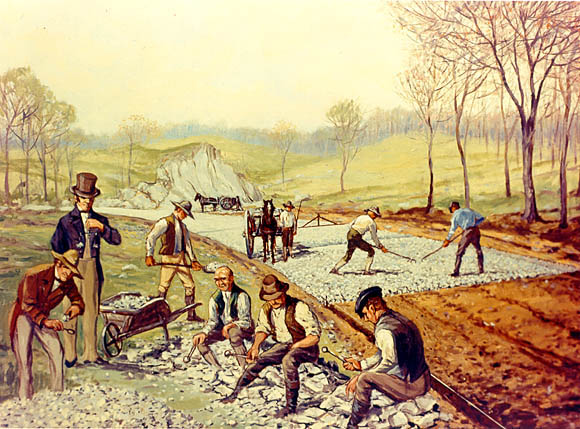
Around 1820, John Loudon McAdam, a Scottish engineer, developed a new road construction technique that was better and cheaper than conventional methods of the time. It came to be called macadam after the man who invented it, and Washington County was the first place in North America to have this type of modern road.
McAdam started thinking about how roads could be improved in 1787 when he became a trustee of the Ayrshire Turnpike in Scotland. He moved to Bristol, England, in 1802 and became the commissioner for paving in 1806. A decade later, he was elected surveyor-general of roads for the turnpike trust.
Not only was he responsible for 149 miles of road, he could put his new construction method to the test. It was actually simpler than other methods of the time that required layers of large rock as a foundation. It was also more effective at protecting the roadway.
McAdam used smaller rocks with only a slight rise from the edges of the road to the center. The size of the rocks needed to be smaller than the width of a wheel, which was typically four-inches wide. The smaller angular rocks acted like a solid mass and created a smoother surface.
Only a few years after McAdam introduced it, macadam was introduced in North America on the Boonsborough Turnpike Road between Hagerstown and Boonsboro. This was the last unimproved section of road that extended the National Road east from Cumberland to Baltimore.
“Stagecoaches using the road in winter needed 5 to 7 hours of travel to cover 10 miles,” according to Curbstone.com.
The builders decided to employ the new macadam process. “Construction specifications for the turnpike road incorporated those set forth by John Loudon McAdam of Scotland,” Curbstone.com reports. “After side ditches were dug, large rocks were picked and raked, then were broken ‘so as not to exceed 6 ounces in weight or to pass a two-inch ring.’ Compacting work for each of the three layers was quickened using a cast-iron roller, instead of allowing for compacting under traffic.”
This last item differed somewhat from McAdam’s process that used the wagons traveling the road to compact it over time.
The success of the road led to macadam being used to repave the National Pike. The 73 miles of road were repaved from 1825 to 1830.
Later engineers took improved on the idea using things like water and tar to keep up with road needs as transportation continued improving. Even today’s more-popular asphalt uses some of the principles of macadam, such as compacting small aggregates on a slight incline. The big difference is that asphalt mixes the aggregates in tar before laying it while tar-sealed macadam sprayed tar on the finished road surface.